Pickleball Statistics 2024 By Game, Players, Regions
At Market.us News, we strive to bring you the most accurate and up-to-date information by utilizing a variety of resources, including paid and free sources, primary research, and phone interviews. Our data is available to the public free of charge, and we encourage you to use it to inform your personal or business decisions. If you choose to republish our data on your own website, we simply ask that you provide a proper citation or link back to the respective page on Market.us News. We appreciate your support and look forward to continuing to provide valuable insights for our audience.
Table of Contents
- Introduction
- Editor’s Choice
- Global Pickleball Market Overview
- History of Pickleball
- Rules and Regulations for Pickleball Statistics
- Annual Growth Rate of Pickleball Statistics
- Number of Pickleball Players
- Total Number of US Pickleball Courts Statistics
- Demographic Distribution of Pickleball Players Statistics
- Professional Pickleball Players Statistics
- Interest in Pickleball Statistics
- Injuries and Costs Incurred During Pickleball
- Recent Developments
- Conclusion
- FAQs
Introduction
Pickleball Statistics: Pickleball, is a fusion of tennis, badminton, and table tennis. It is played on a court smaller than a tennis court, divided into service courts and a non-volley zone.
It is widely played in the United States. Players wield solid paddles and a plastic ball, aiming to score points through rallies. The underhand serve diagonally initiates each point, requiring clearance over the net and into the opponent’s court.
Volleys are permitted after the double bounce rule except within the non-volley zone. Doublesplay emphasizes communication and court coverage, while singles demand individual court mastery.
Good sportsmanship and self-regulation are core to pickleball’s ethos, fostering a welcoming and inclusive community.
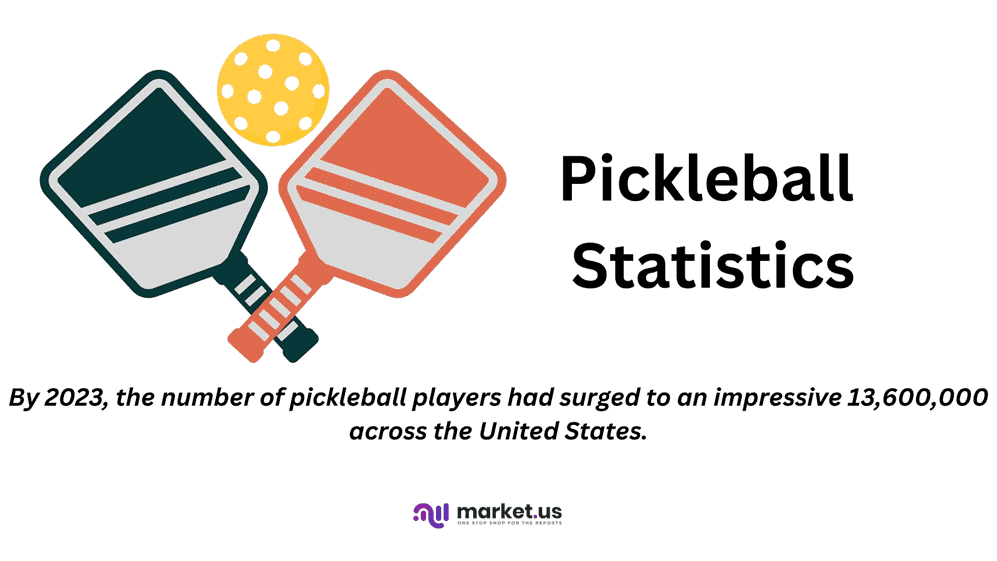
Editor’s Choice
- The global pickleball market will reach approximately $3,859.0 million by 2032.
- As of the latest data, offline channels hold a slight majority, accounting for 51.80% of the market share.
- Pickleball is a sport that combines elements of tennis, badminton, and table tennis. It was invented in 1965 by Joel Pritchard, Bill Bell, and Barney McCallum on Bainbridge Island near Seattle, Washington.
- The annual growth rate of pickleball continued at a strong pace in 2021, with a rate of 14.80%.
- By 2023, the number of players had surged to an impressive 13,600,000. They indicated a robust and expanding interest in pickleball across the United States.
- Florida leads with 1,071 locations, closely followed by California, which boasts 1,048 places to play pickleball.
- The gender distribution among pickleball players reveals a significant disparity. With males comprising 60.50% of the participant base, while females account for 39.50%.
- In 2023, injuries related to pickleball are projected to lead to $377 million in healthcare expenditures in the U.S. Representing 5% to 10% of all unanticipated medical costs for the year.
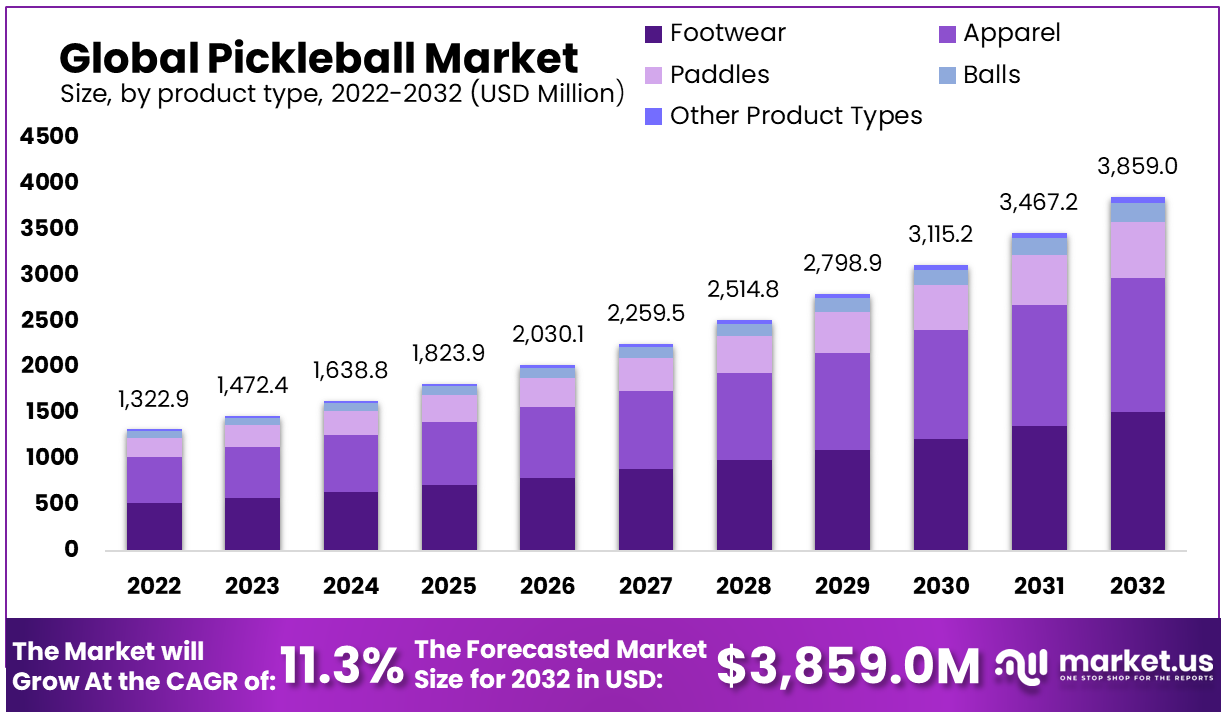
Global Pickleball Market Overview
Global Pickleball Market Size Statistics
- The global pickleball market has demonstrated robust growth. With revenue increasing significantly over a ten-year forecast period at a CAGR of 11.30%.
- In 2022, the market was valued at approximately $1,322.9 million.
- This figure rose to $1,472.4 million in 2023 and is projected to further escalate to $1,638.8 million in 2024. By 2025, the market is expected to reach $1,823.9 million.
- The upward trend continues, with the market anticipated to grow to $2,030.1 million in 2026, and by 2027, revenues are forecasted to climb to $2,259.5 million.
- The market is predicted to surpass the $2.5 billion mark in 2028, with revenues reaching $2,514.8 million. By 2029, it is estimated to expand to $2,798.9 million.
- The momentum is projected to carry forward into the next decade, with the market expected to achieve $3,115.2 million in 2030, $3,467.2 million in 2031, and approximately $3,859.0 million by 2032.
- This trajectory highlights the increasing popularity and commercial potential of pickleball globally.
(Source: Statista)
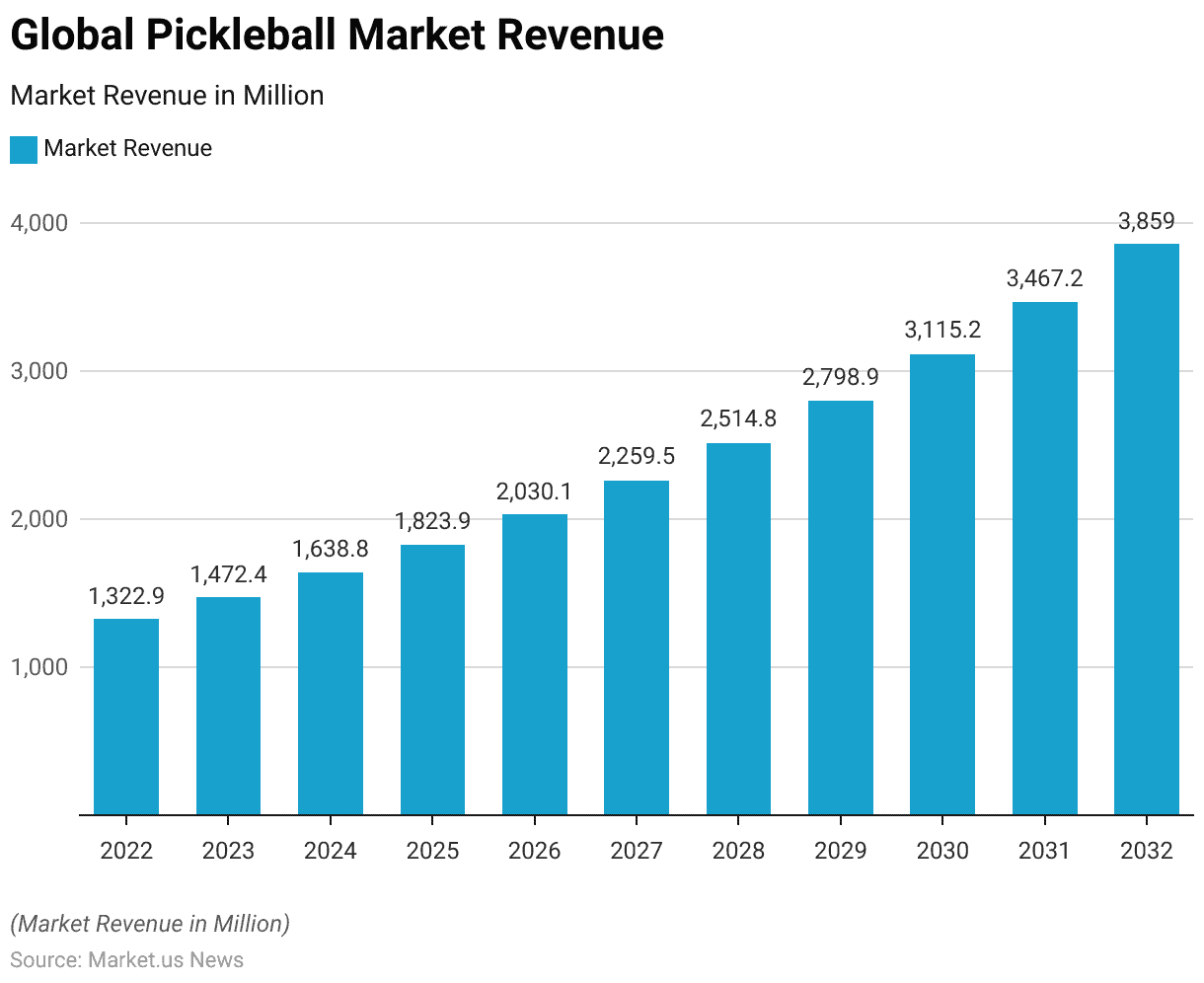
Global Pickleball Market Share – By Distribution Channel Statistics
- The distribution of the global pickleball market is nearly evenly split between offline and online channels.
- As of the latest data, offline channels hold a slight majority, accounting for 51.80% of the market share.
- This indicates a robust presence of traditional retail outlets and physical store sales in the industry.
- Conversely, online sales channels have also captured a significant portion of the market, with a 48.20% share.
- This reflects a strong consumer preference for the convenience and accessibility offered by online shopping. Highlighting the importance of digital platforms in the distribution of pickleball equipment and related products.
(Source: Statista)
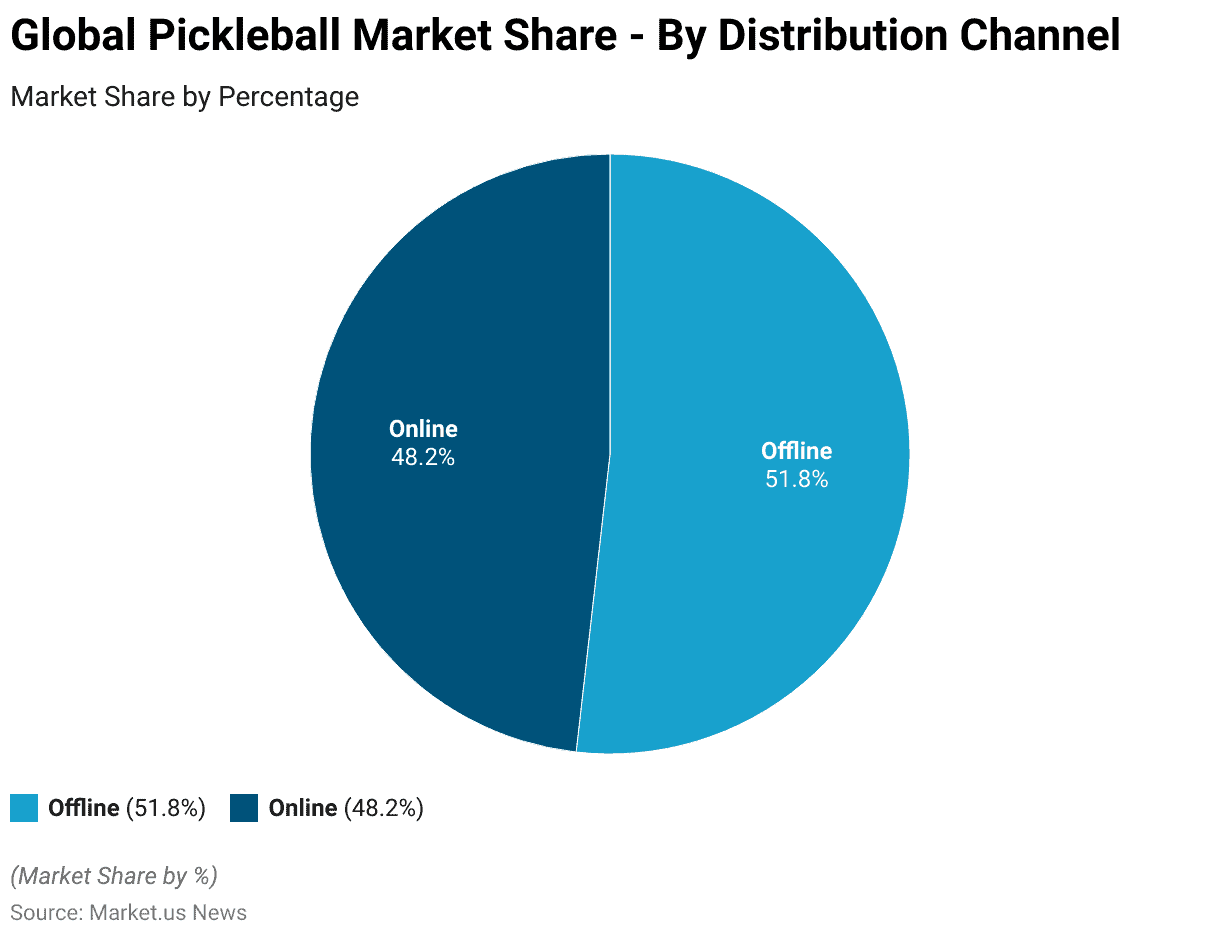
History of Pickleball
- Pickleball, a sport that combines elements of tennis, badminton, and table tennis, was invented in 1965 by Joel Pritchard, Bill Bell, and Barney McCallum on Bainbridge Island near Seattle, Washington.
- Originally designed as a family game, pickleball has seen exponential growth over the decades.
- By the 1970s, the sport was formally organized with the establishment of rules and the founding of the USA Pickleball Association in 1984. Which standardized the game and facilitated its growth across community centers, schools, and parks.
- The 1990s saw the creation of the first composite paddle, which significantly changed how the game was played and contributed to its popularity.
- The 2000s marked a pivotal expansion as the sport gained a foothold in retirement communities, particularly in the Sunbelt states, where it became a staple activity.
- In the following decade, pickleball’s appeal broadened to a younger demographic, contributing to a surge in its popularity.
- According to the Sports & Fitness Industry Association, by 2021, pickleball participation had increased to over 4.8 million players in the U.S. Representing a 650% increase over the previous six years.
- This rapid growth attracted significant investment in pickleball equipment and infrastructure, with numerous manufacturers entering the market and the development of specialized courts.
(Source: USA Pickleball)
Rules and Regulations for Pickleball Statistics
- As of 2024, pickleball has seen significant growth, necessitating standardized regulations to ensure fair play, safety, and consistency across different regions.
- The official rules stipulate that paddles must be made from composite materials and not exceed specific dimensions, while balls should meet defined bounce and hardness criteria.
- Courts are required to be 44 feet long and 20 feet wide, with a net height of 36 inches at the sidelines and 34 inches at the center, including marked non-volley zones or ‘kitchens.’
- Gameplay rules mandate that scoring is typically to 11, 15, or 21 points, requiring a two-point lead to secure a win.
- Serves must be underhand and below the waist, with faults including out-of-bounds hits and non-volley zone violations. Player conduct rules emphasize sportsmanship and penalize misconduct with warnings or disqualification.
- Tournaments are organized by categories such as age and skill level and require certified referees to ensure adherence to the rules.
- Additionally, safety protocols call for regular equipment inspections and court maintenance to prevent injuries.
(Source: USA Pickleball Association (USAPA)
Annual Growth Rate of Pickleball Statistics
- The annual growth rate of the pickleball market has shown notable fluctuations over the period from 2017 to 2022.
- Starting in 2017, the market grew by 11.30%. The growth rate then decelerated over the next two years, dropping to 5.40% in 2018 and further to 4.80% in 2019.
- However, a significant surge occurred in 2020, when the growth rate increased dramatically to 21.40%, likely driven by changing consumer behaviors and increased interest in outdoor and socially-distanced sports amid global health events.
- The growth continued at a strong pace in 2021, with a rate of 14.80%.
- The most striking increase happened in 2022, when the growth rate skyrocketed to 85.70%, indicating a massive expansion in the market’s reach and consumer engagement, possibly fueled by broader adoption and heightened awareness of the sport.
(Source: SFIA Single Sport Participation Report on Pickleball)
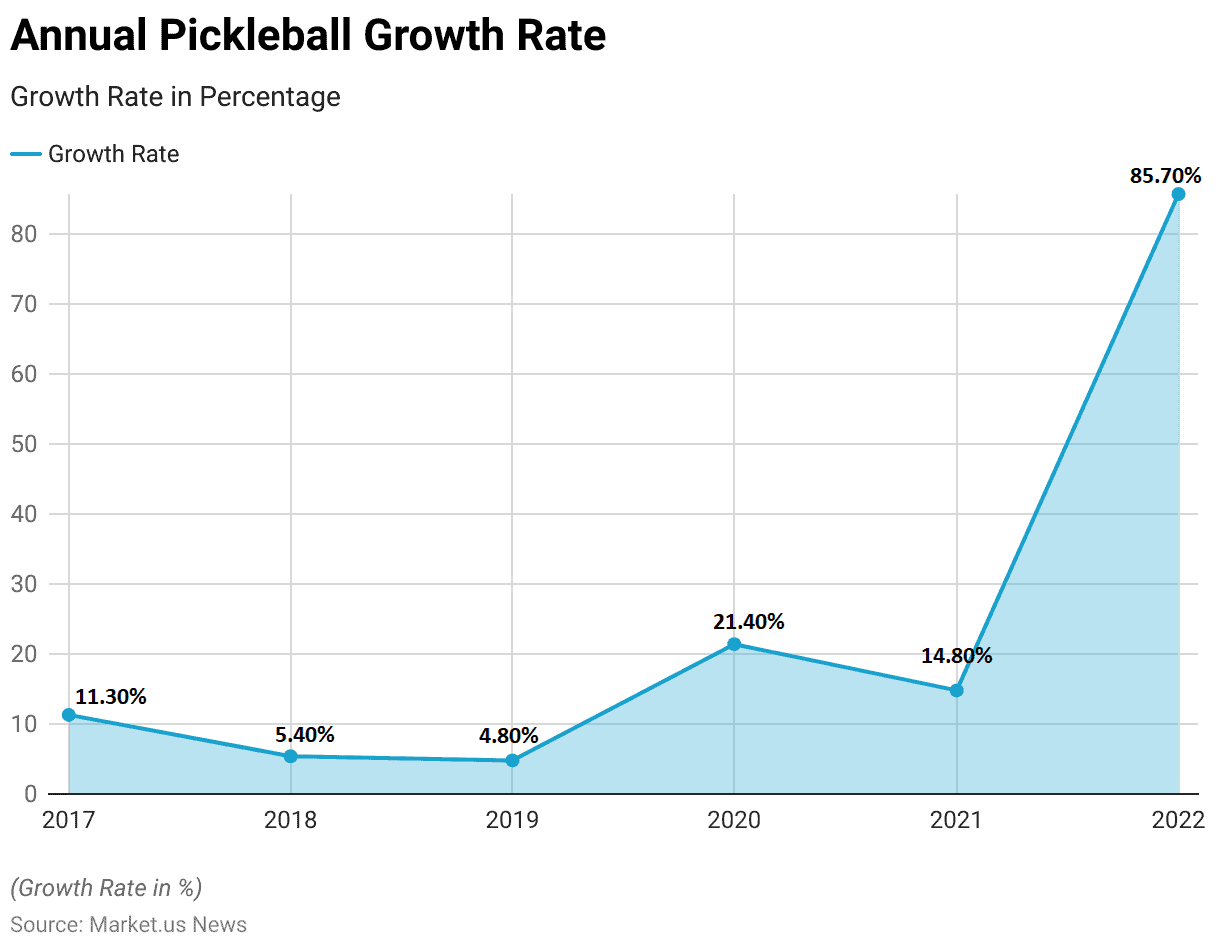
Number of Pickleball Players
- The number of pickleball players in the U.S. has experienced substantial growth from 2017 to 2023.
- In 2017, the total number of pickleball players was approximately 3,132,000.
- This figure grew moderately over the next two years, reaching 3,301,000 in 2018 and further increasing to 3,460,000 by 2019.
- A significant jump occurred in 2020, with the total rising to 4,200,000 players, reflecting a growing interest in the sport, possibly due to its social distancing-friendly nature during global health events.
- This upward trajectory continued into 2021 when the player base expanded to 4,820,000.
- The growth peaked dramatically in 2022, nearly doubling the previous year’s total to 8,900,000.
- By 2023, the number of players had surged to an impressive 13,600,000, indicating a robust and expanding interest in pickleball across the United States.
(Source: SFIA Topline Report)
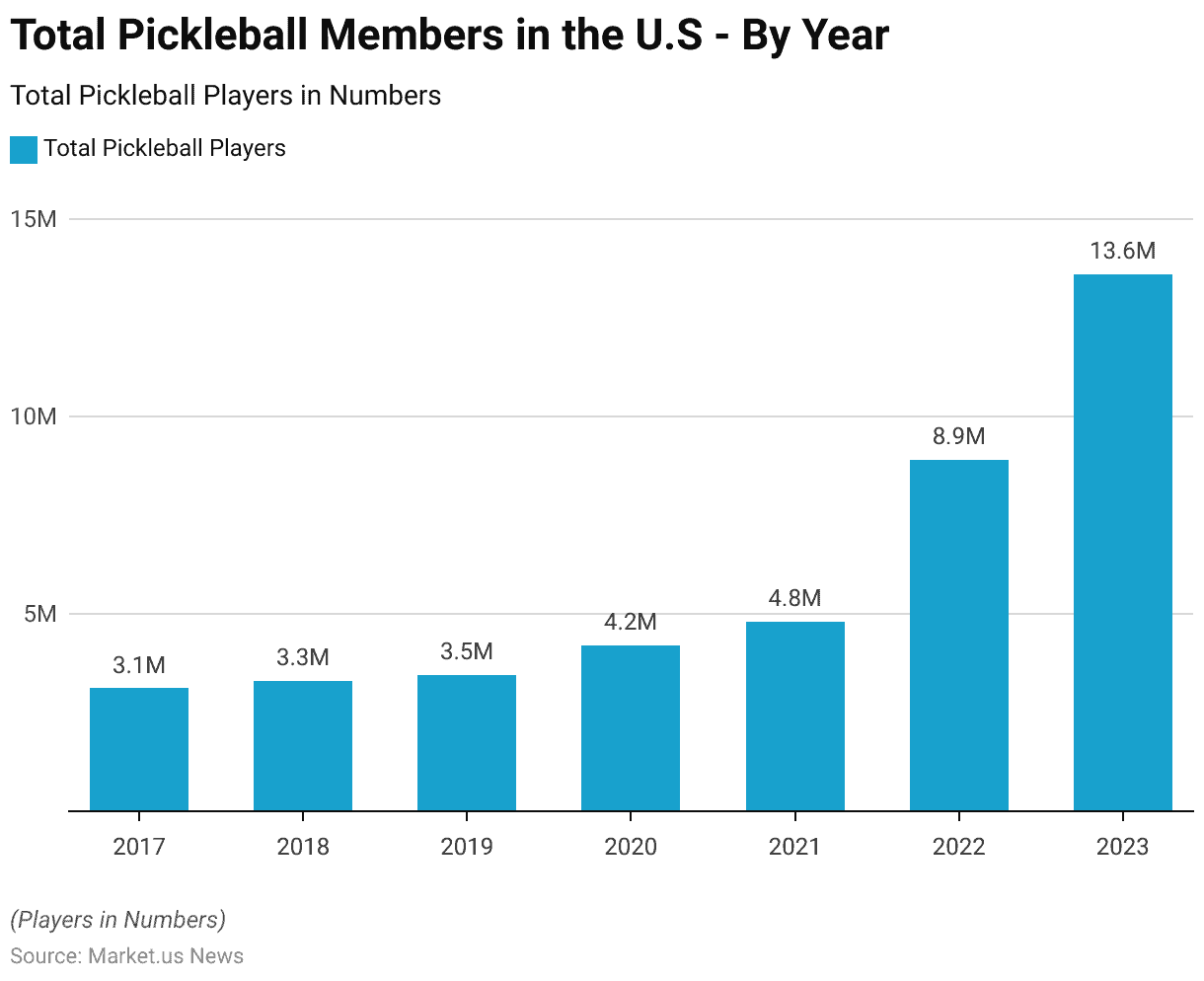
Total Number of US Pickleball Courts Statistics
Pickleball Courts by State Statistics
- The distribution of pickleball locations across various states in the U.S. highlights the sport’s widespread popularity.
- Florida leads with 1,071 locations, closely followed by California, which boasts 1,048 places to play pickleball.
- Texas ranks third with 755 locations.
- New York and North Carolina each have a significant number of venues, with 586 and 525 locations, respectively, the latter being matched by Illinois, which also has 525.
- Ohio slightly exceeds these with 528 locations.
- Michigan and Pennsylvania also contribute to the national availability with 465 and 447 locations, respectively.
- Washington state rounds out the list with 417 pickleball locations, illustrating a robust national infrastructure supporting the growth of this sport.
(Source: USA Pickleball)
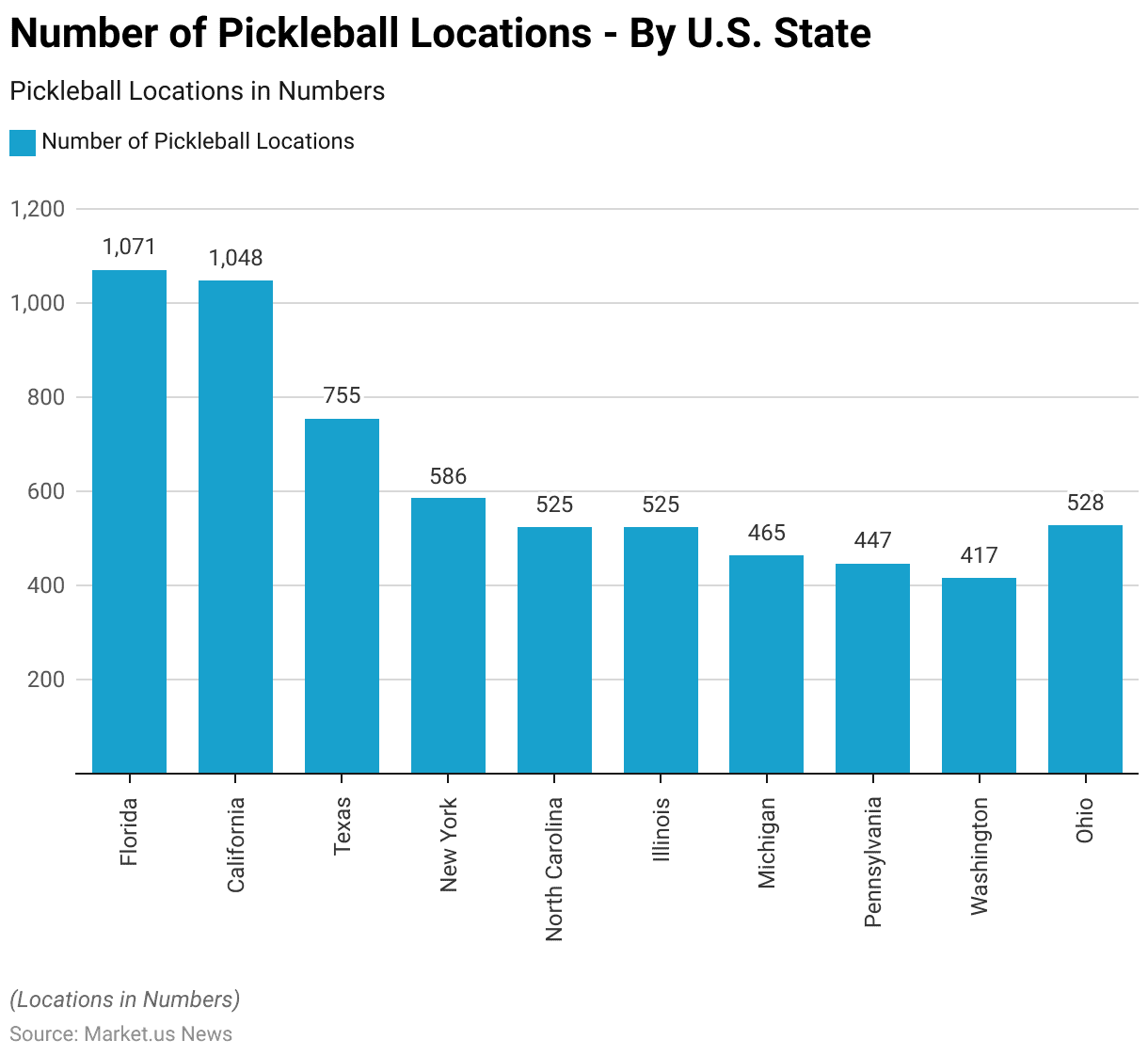
Pickleball Courts by City Statistics
- Pickleball locations are strategically distributed across major cities in the U.S., reflecting the sport’s growing urban popularity.
- New York, NY, leads with the highest number of locations at 58, closely followed by Houston, TX, which has 51 pickleball venues.
- Seattle, WA, also shows strong participation with 48 locations.
- Atlanta, GA, and Denver, CO, each have a robust presence with 44 and 43 locations, respectively, the latter number being matched by Chicago, IL. Las Vegas, NV, and Cincinnati, OH, each offer 41 places to play.
- Austin, TX, is not far behind with 40 locations, and San Diego, CA, contributes to the national scene with 39 pickleball venues.
- These figures highlight the sport’s integration into the recreational fabric of these diverse urban centers.
(Source: USA Pickleball)
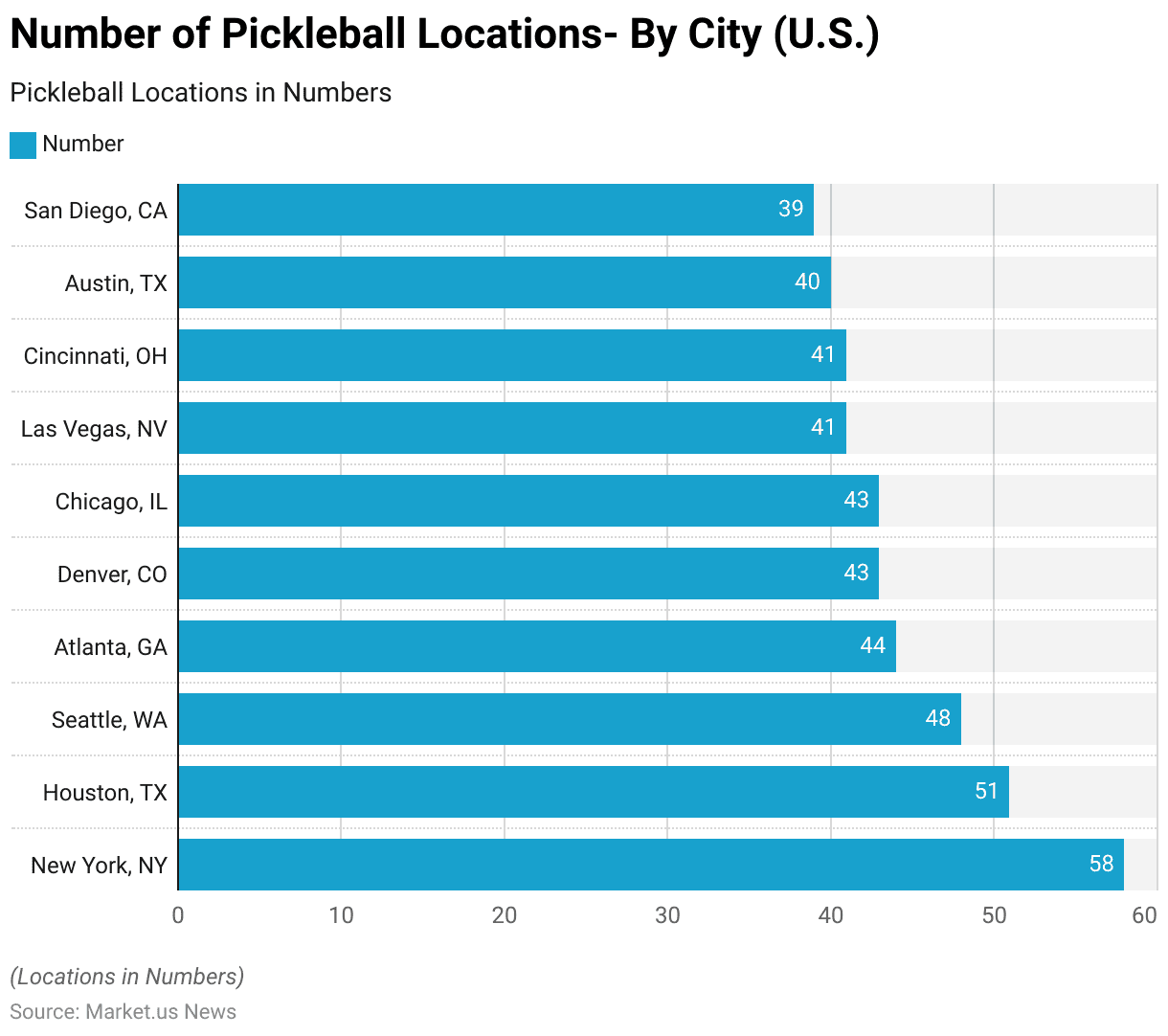
Pickleball Players by Region Statistics
- The distribution of pickleball players across different U.S. regions varies significantly, with the South Atlantic region leading with 1,087,000 players, encompassing states such as Florida, Georgia, South Carolina, North Carolina, Virginia, West Virginia, and the District of Columbia.
- The East North Central region follows with 801,000 players across Wisconsin, Michigan, Illinois, Ohio, and Indiana.
- The Pacific region, which includes California, Oregon, and Washington, also has a substantial number of enthusiasts, totaling 780,000 players.
- Lastly, the Mid-Atlantic region, comprising New Jersey, New York, Pennsylvania, and West Virginia, hosts 675,000 players.
- This regional distribution underscores the widespread popularity and participation in pickleball across diverse geographic areas in the United States.
(Source: USA Pickleball)
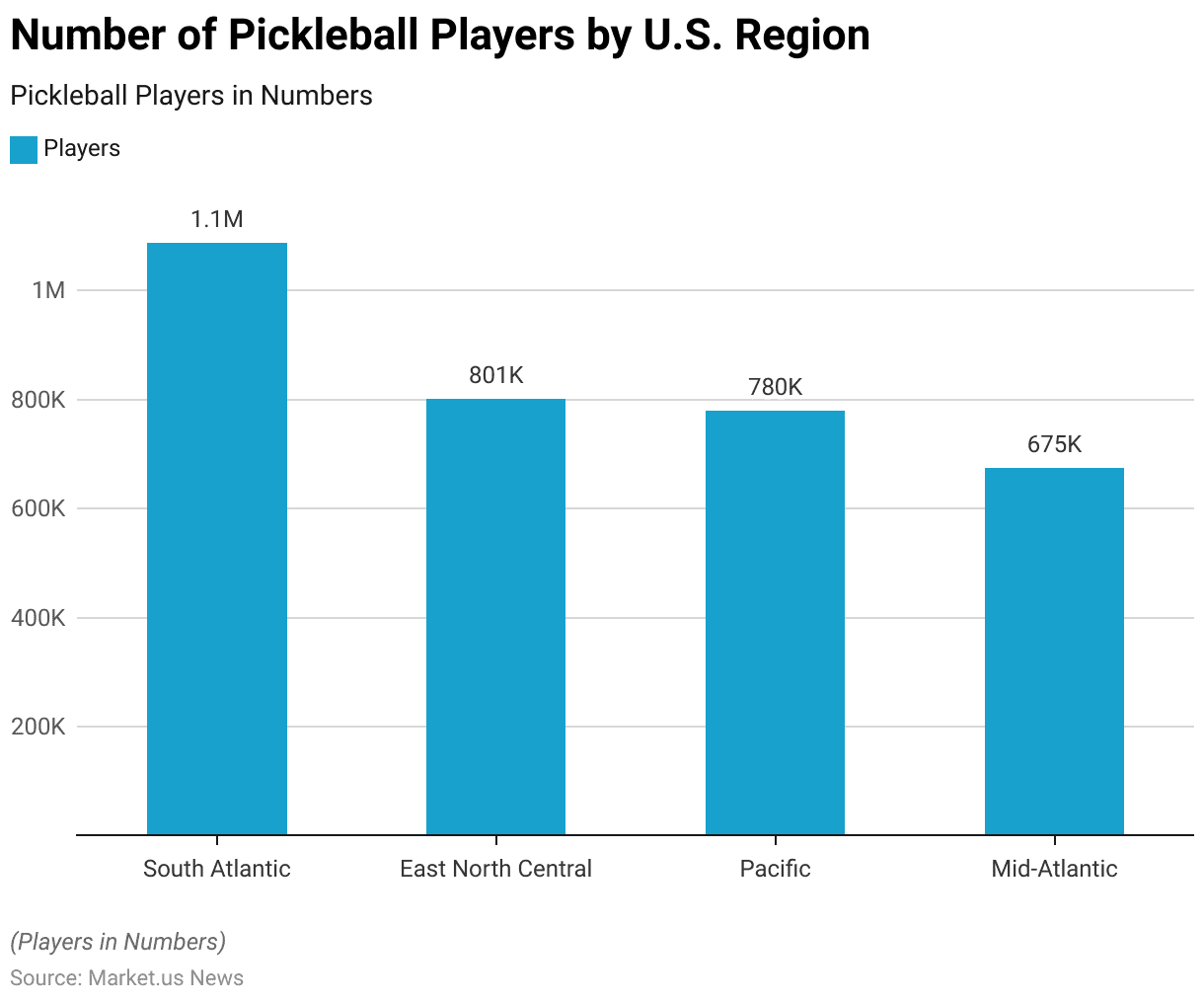
Demographic Distribution of Pickleball Players Statistics
By Age
- The demographic distribution of pickleball players across different age groups presents a diverse landscape of participation in the sport.
- The youngest group, aged 6 to 17, represents 21.20% of the total players, with 14.20% being core players and 23.90% casual players.
- Those aged 18 to 34 make up the largest segment, constituting 28.80% of players; within this group, 16.80% are core players, while a significant 33.50% play casually.
- The 35 to 54 age group accounts for 20.40% of the total, with 17% as core and 21.80% as casual players.
- Adults between 55 and 64 years hold a smaller share at 12%, but they have a higher proportion of core players at 19.20%, compared to 9.20% who are casual.
- Lastly, the 65 and older group, which forms 17.60% of the player base, has the highest percentage of core players at 32.70% and 11.60% casual players.
- This distribution highlights the broad appeal of pickleball, engaging a wide range of ages with varying levels of commitment to the sport.
(Source: Pickleballify)
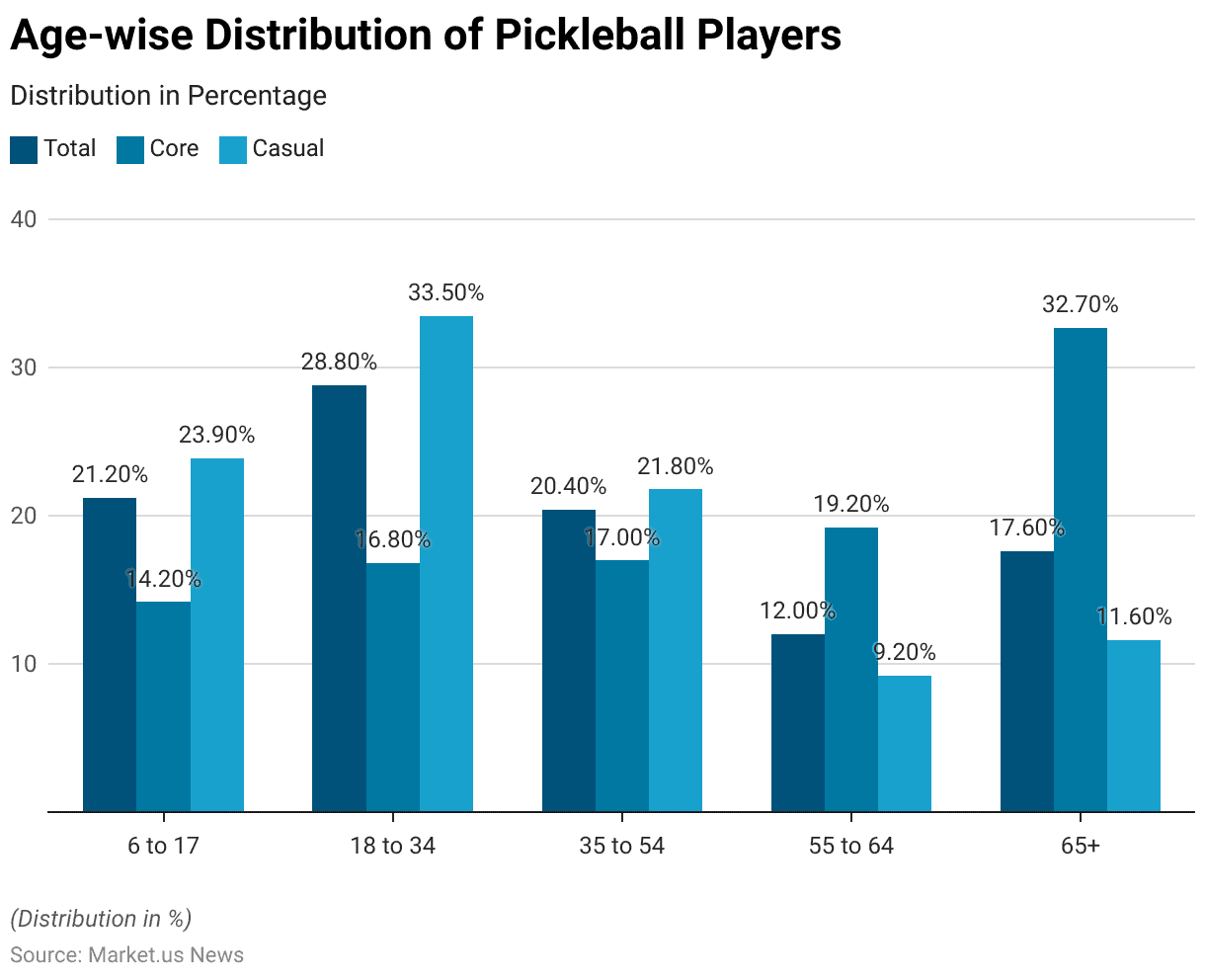
By Gender
- The gender distribution among pickleball players reveals a significant disparity, with males comprising 60.50% of the participant base, while females account for 39.50%.
- This indicates a dominant male presence in the sport, reflecting broader participation trends that may influence aspects like marketing strategies, program development, and community engagement initiatives aimed at achieving a more balanced gender representation within the sport of pickleball.
(Source: SFIA Single Sport Participation Report on Pickleball)
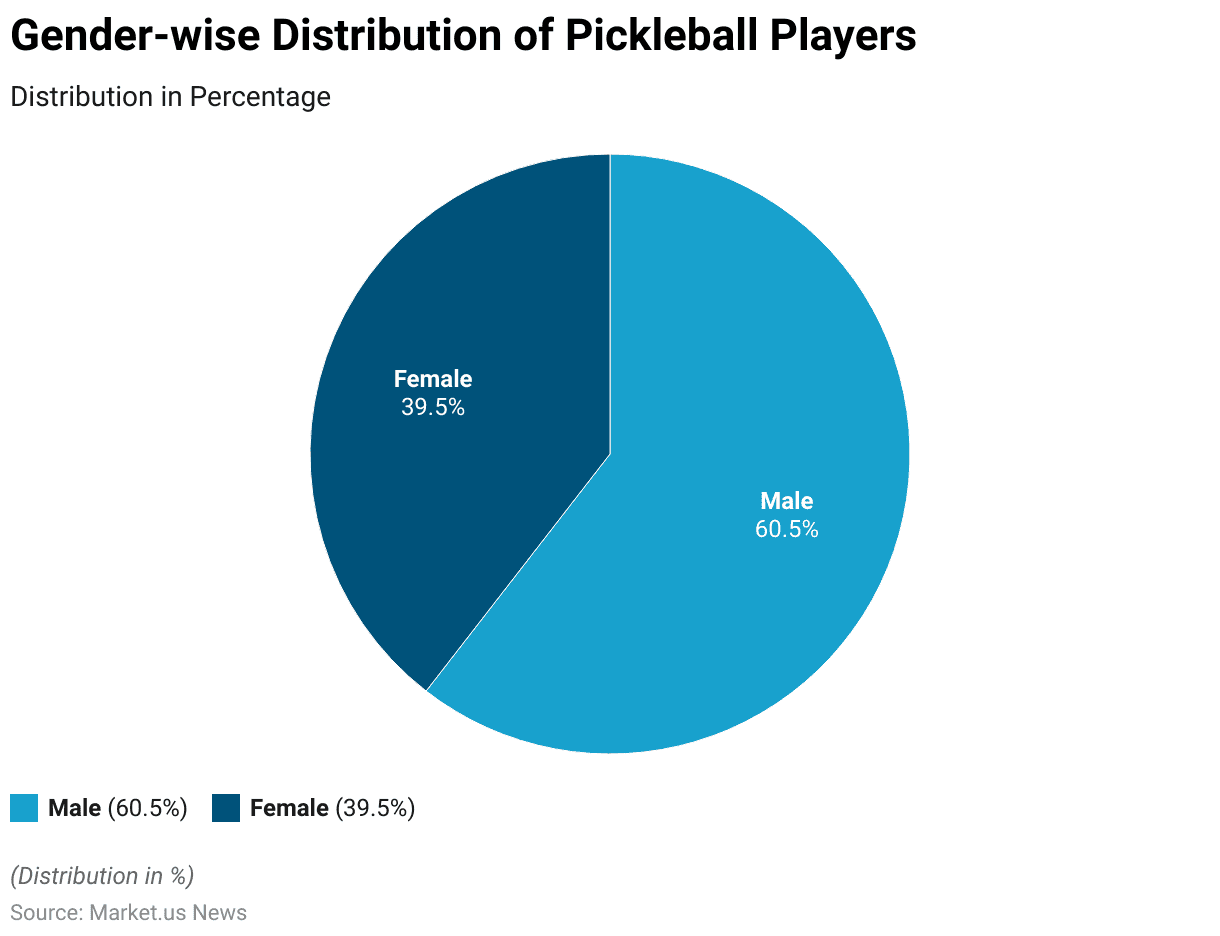
Income Disparity
- The income score among pickleball players has demonstrated variability over the years from 2014 to 2022.
- Starting in 2014, the score was relatively low at 1.83 but showed a slight increase to 1.96 in 2015.
- It dipped slightly in 2016 to 1.79 before rising steadily in the subsequent years, reaching 2.07 in 2017, 2.43 in 2018, and peaking at 2.83 in 2019.
- However, there was a noticeable decline to 2.61 in 2020, possibly influenced by economic factors.
- The score further decreased to 2.48 in 2021, and in 2022, it saw a significant drop to 1.90.
- This trend reflects changes in the economic status or spending power of the pickleball-playing community over the years.
(Source: State of Pickleball: Participation & Infrastructure Report – 2023)
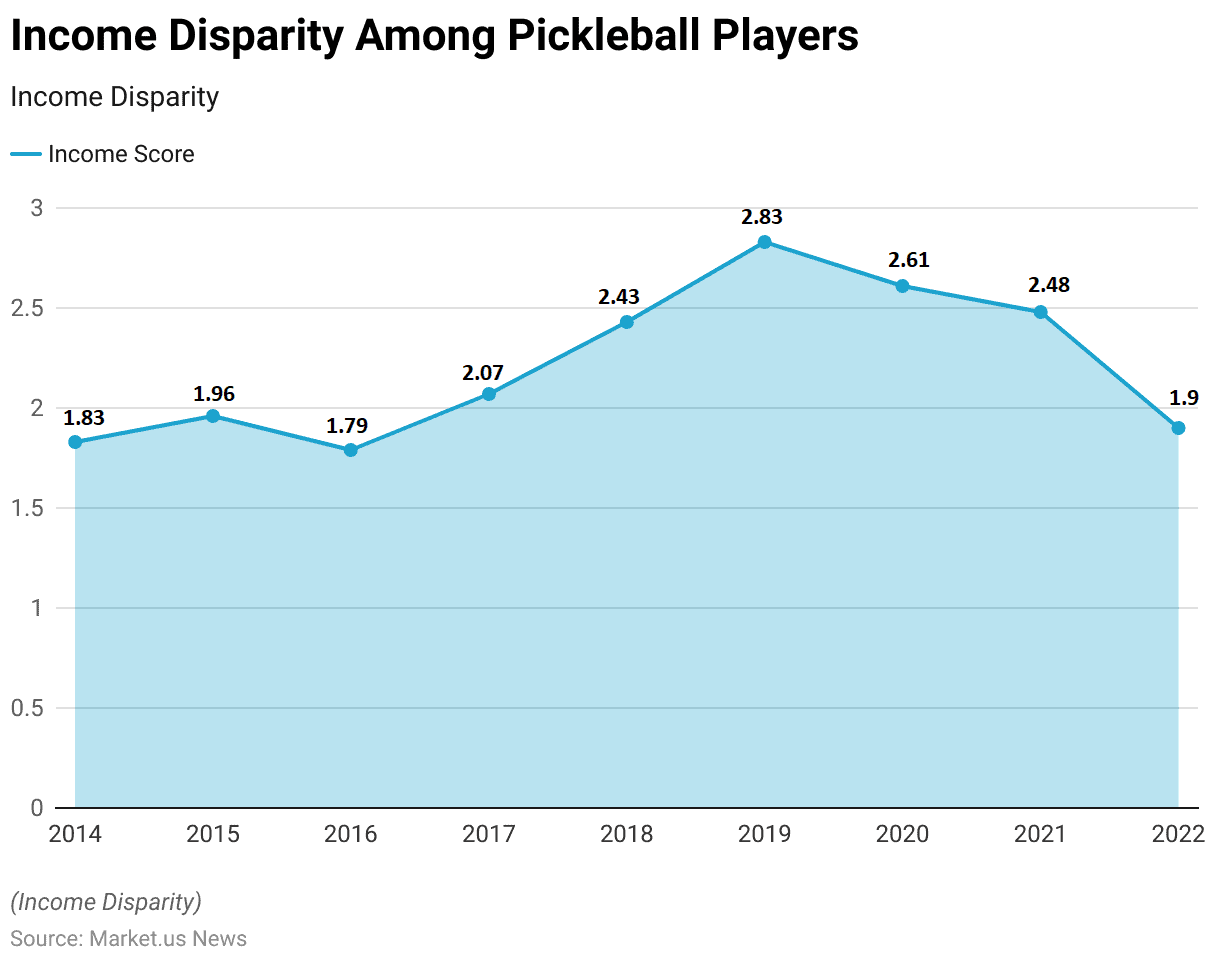
Professional Pickleball Players Statistics
Top 10 Ranked Players – Mens Singles
- The ranking of pickleball players based on points features Collin Johns at the top with 16,000 points, sponsored by Electrum.
- Following him is Ben Johns, who has accumulated 14,900 points and is sponsored by Joola.
- Riley Newman holds the third position with 14,200 points under the sponsorship of Takeya.
- Matt Wright, sponsored by Onix, is not far behind with 14,000 points.
- The fifth spot is held by Dylan Frazier, who has garnered 9,075 points and is associated with Selkirk.
- JW Johnson, with 9,000 points, is sponsored by Franklin and occupies the sixth rank.
- The seventh and eighth positions are filled by Jay Devilliers and Tyler Loong, both sponsored by Vulcan, with points tallying at 5,870 and 5,415, respectively.
- Rounding out the top ten are AJ Koller and Callan Dawson, with Koller sponsored by Fromuth and earning 5,000 points, and Dawson just behind at 4,990 points, sponsored by ProKennex.
- This lineup underscores the competitive landscape and the significant role of sponsorships in professional pickleball.
(Source: PPA Tour)
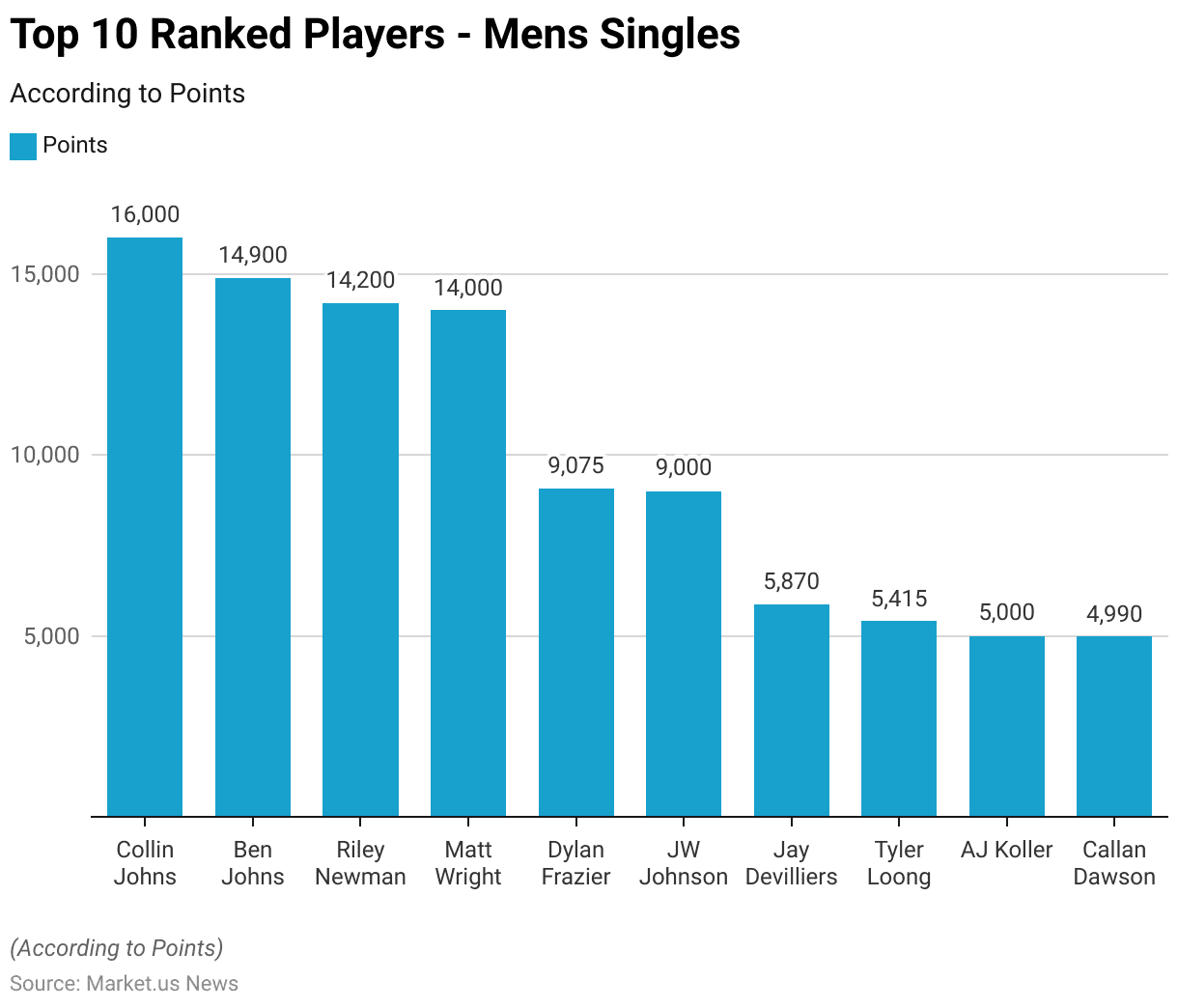
Top 10 Ranked Players – Women’s Singles
- The ranking of the top 10 women’s singles pickleball players is led by Anna Leigh Waters. Who tops the chart with 15,300 points and is sponsored by Paddletek.
- Following her is Lea Jansen from Joola, who has accumulated 10,930 points. Catherine Parenteau also makes a strong showing, holding the third position with 10,480 points under Selkirk sponsorship.
- Salome Devidze is in fourth place with 8,860 points and is currently not affiliated with a sponsor. Irina Tereschenko, another Paddletek athlete, is ranked fifth with 3,865 points.
- Close behind is Mary Brascia, who scored 3,790 points, representing Selkirk. Brooke Buckner, sponsored by Joola, is seventh with 2,573 points.
- The eighth position is occupied by Callie Smith of Onix, who has earned 1,615 points. Yana Grechkina, representing CRBN, is just five points behind Smith, with 1,610 points.
- Rounding out the top ten is Anna Bright, also from Joola, with 1,540 points.
- This ranking highlights the competitive spirit and diverse sponsorships within the women’s singles pickleball circuit.
(Source: PPA Tour)
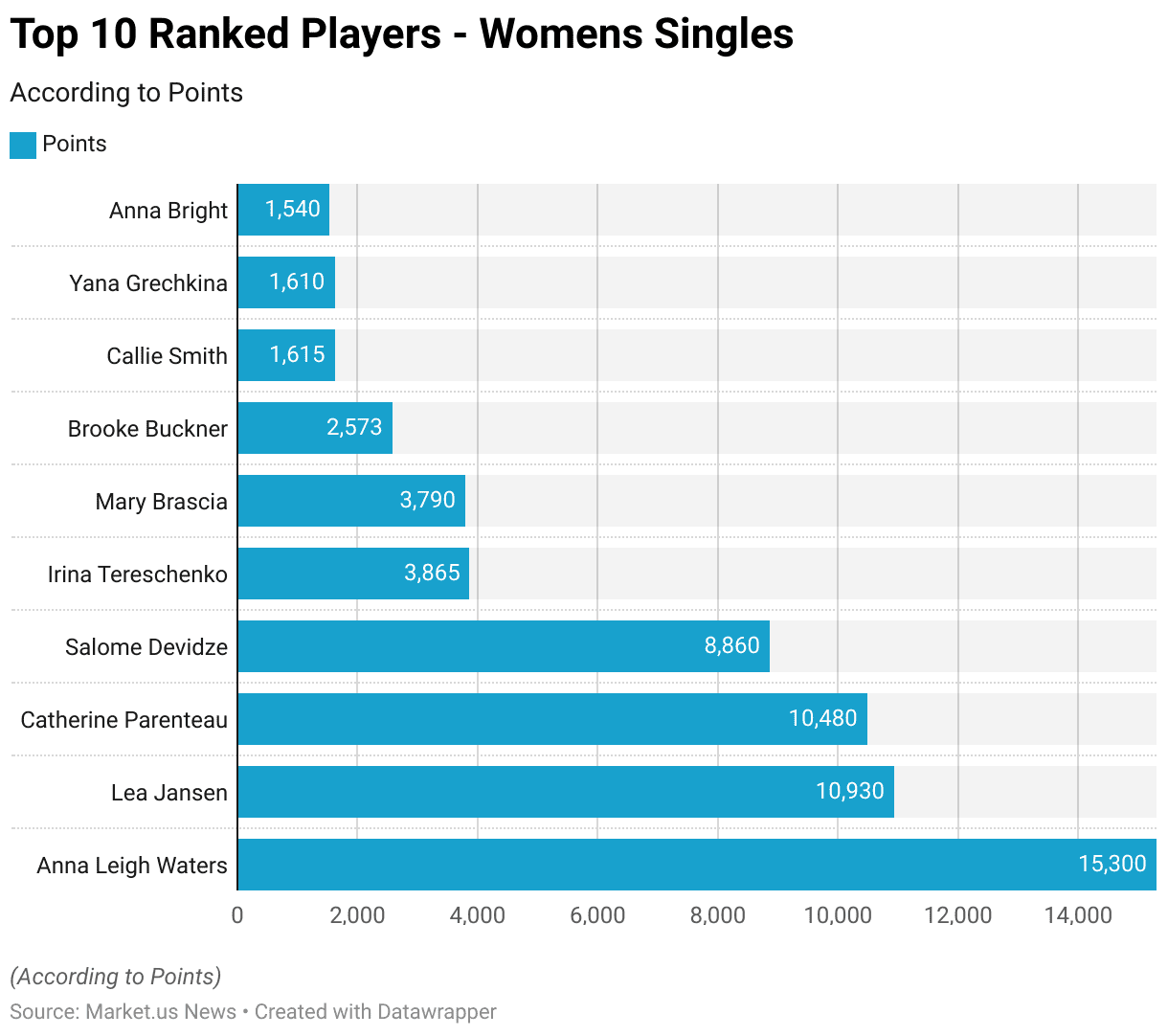
Interest in Pickleball Statistics
- According to Google Trend scores, Utah leads in interest for pickleball with a perfect score of 100. Indicating the highest level of online search activity related to the sport.
- Following closely behind is Arizona, with a score of 73, while Hawaii and Minnesota exhibit slightly lower but still substantial interest levels, with scores of 61 and 60, respectively.
- Florida rounds out the top five states with a score of 59, showcasing a notable level of curiosity and engagement in pickleball.
- These scores suggest a widespread and growing interest in pickleball across various regions. Reflecting its increasing popularity as a recreational activity and competitive sport.
(Source: Google Trends)
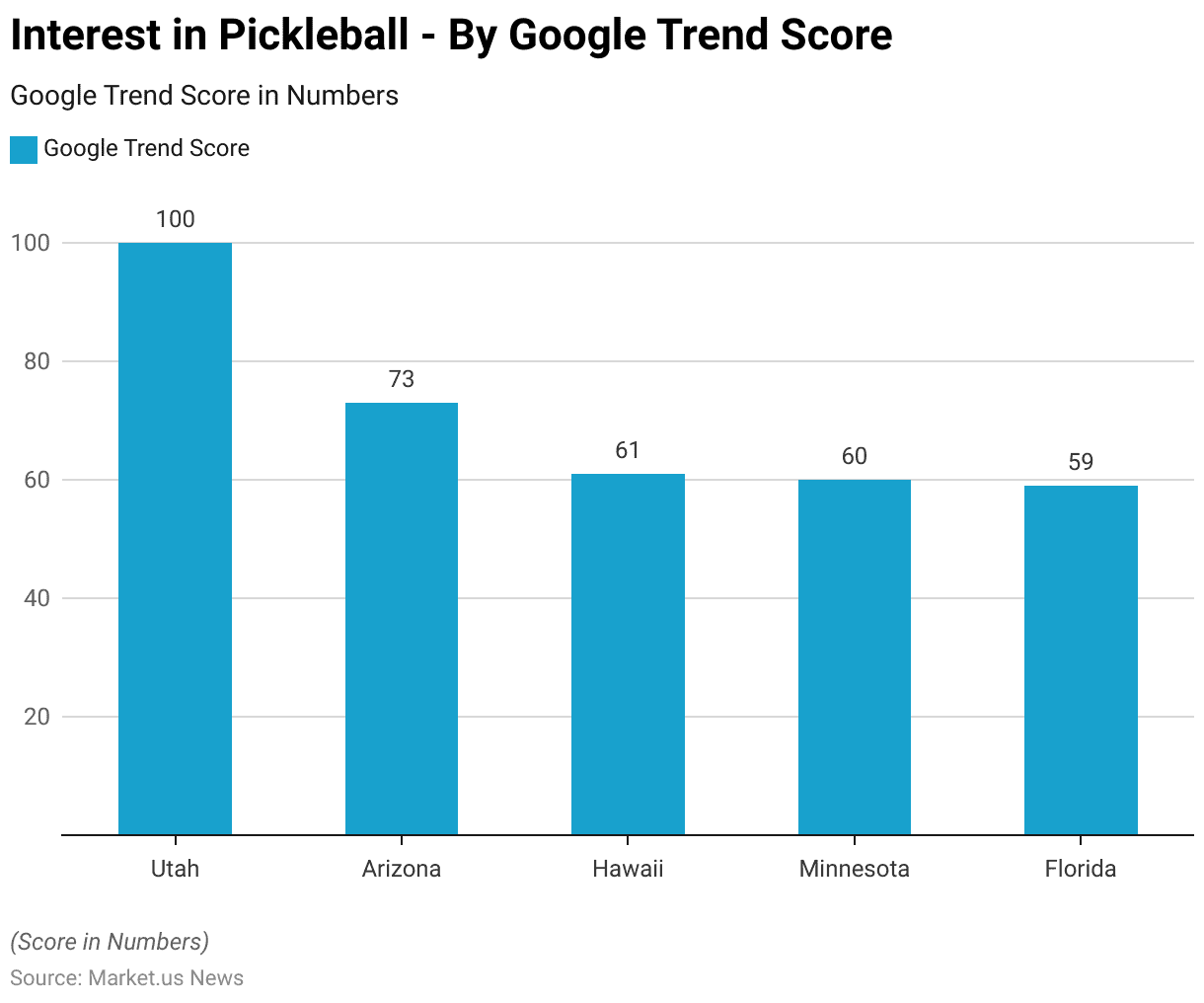
Injuries and Costs Incurred During Pickleball
- In 2023, injuries related to pickleball are projected to lead to $377 million in healthcare expenditures in the U.S., representing 5% to 10% of all unanticipated medical costs for the year.
- According to a 2021 study, pickleball injuries predominantly affect the elderly. 86% of emergency department visits from 2010 to 2019 involved individuals over 60 years of age.
- The majority of these injuries, approximately 60%, include sprains, strains, and fractures.
- Around 20% of the injuries consist of contusions, abrasions, or internal damage. While lacerations and dislocations make up less than 10%.
- Analysts anticipate about 67,000 emergency room visits, 366,000 outpatient consultations, and 9,000 outpatient surgical procedures related to pickleball injuries within the year.
(Source: PubMed)
Recent Developments
Acquisitions and Mergers:
Acquisition of PickleballCentral by Escalade Sports: In a strategic move to expand its presence in the pickleball market. Escalade Sports acquired PickleballCentral, a leading online retailer of pickleball equipment and accessories. This acquisition aims to strengthen Escalade Sports’ position in the rapidly growing pickleball industry.
New Product Launches:
PaddleTek Launches Innovative Pickleball Paddle: PaddleTek, is a prominent manufacturer of pickleball equipment. They introduced a new advanced pickleball paddle featuring enhanced technology for improved control and power. The paddle’s launch has garnered significant attention from pickleball enthusiasts seeking high-performance equipment.
Funding Rounds:
Pickleball Marketplace Secures $5 Million in Series A Funding: Pickleball Marketplace, an emerging e-commerce platform specializing in pickleball gear, raised $5 million in its Series A funding round. The investment will be utilized to expand the company’s product offerings, enhance its technological infrastructure, and fuel marketing initiatives to capture a larger market share.
Tournament Growth:
Surge in Participation in Pickleball Tournaments: The past year witnessed a remarkable increase in the number of participants in pickleball tournaments across the globe. Data reveals a 30% year-over-year growth in tournament registrations, indicating the growing popularity of the sport and the expanding pickleball community.
Corporate Partnerships:
Nike Enters Pickleball Market Through Partnership with Top Players: In a strategic move to tap into the burgeoning pickleball market, Nike announced partnerships with elite pickleball players to promote its line of pickleball apparel and footwear. This collaboration aims to leverage the players’ influence to drive brand awareness and sales within the pickleball community.
Expansion of Pickleball Facilities:
Surge in Construction of Pickleball Courts in Community Centers: Municipalities and community centers have witnessed a surge in the construction of pickleball courts to meet the growing demand for recreational pickleball activities. Data indicates a 40% increase in the number of pickleball courts constructed in the past year, reflecting the sport’s rising popularity and accessibility.
Market Penetration Strategies:
Pickleball Equipment Manufacturers Focus on International Expansion: Leading pickleball equipment manufacturers have intensified their efforts to penetrate international markets, particularly in regions with nascent pickleball communities. Expansion strategies include establishing distribution networks, partnering with local retailers, and conducting targeted marketing campaigns to raise awareness and stimulate demand for pickleball products.
Conclusion
Pickleball Statistics – In conclusion, pickleball emerged from its modest beginnings in 1965 as a backyard family game to become one of the fastest-growing sports in the United States.
Its appeal spans generations, largely due to its easy-to-learn nature and the low physical impact of play. Making it accessible to a wide demographic, including seniors and young people alike.
The sport’s growth is supported by a significant increase in the number of players. Which has spurred the development of specialized equipment and infrastructure.
The economic implications are substantial, with a thriving market for pickleball products and the generation of economic activity through tournaments and events that attract participants from various regions.
As more communities and schools adopt pickleball, its popularity is expected to continue rising, further solidifying its status as a major sport in America and increasingly around the world.
FAQs
Pickleball is a paddle sport that combines elements of tennis, badminton, and table tennis. It is played with a paddle and a plastic ball with holes, either as doubles or singles.
Pickleball is played on a court similar to a badminton court with a net that is slightly lower than a tennis net. The game can be played as singles or doubles, and the objective is to score points by hitting the ball over the net within the boundaries of the opponent’s court.
The basic equipment includes a pickleball paddle, which is smaller than a tennis racket but larger than a ping-pong paddle, and a pickleball, a light plastic ball with holes. It would help if you also had a pickleball court with a net.
Yes, pickleball is a popular sport among all age groups. Seniors particularly favor it due to its low-impact nature, but it is also increasingly popular among younger players.
Playing pickleball provides cardiovascular exercise, improves agility, enhances reflexes, and builds social connections. It is a fun way to improve fitness levels while enjoying competitive play.
Sources.

Tajammul Pangarkar
Tajammul Pangarkar is a tech blogger that frequently contributes to numerous industry-specific magazines and forums. Tajammul longstanding experience in the fields of mobile technology and industry research is often reflected in his insightful body of work. His interest lies in understanding tech trends, dissecting mobile applications, and in raising a general awareness of technical know-how. When he’s not ruminating about various happenings in the tech world, he can be usually found indulging in his next favorite interest - table tennis.
Latest from Author
- Coin Cell Batteries Market Sales to Top USD 6.36 Bn by 2033
- Cruise Itineraries Span the Globe, Offering Access to A Wide Range of Destinations
- Cruise Statistics 2024 By Travel, Locations, Fares
- Dropshipping Businesses to Thrive With Rapid Expansion of E-Commerce Platforms
- Dropshipping Statistics 2024 By Location, Sellers, Buyers